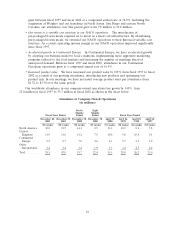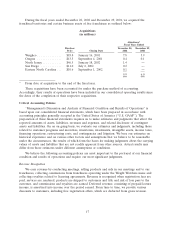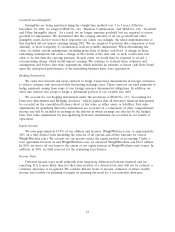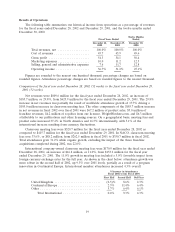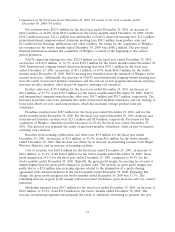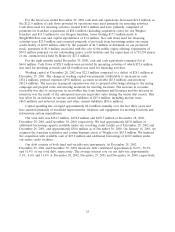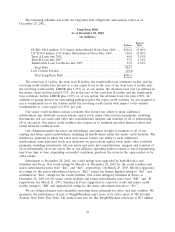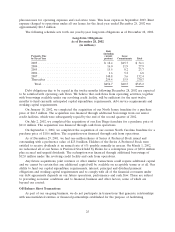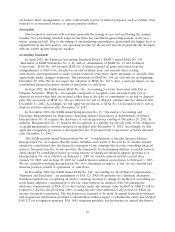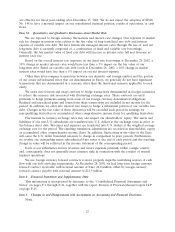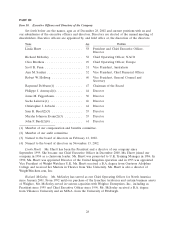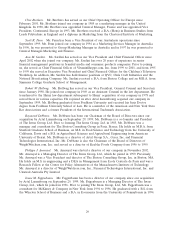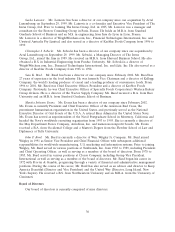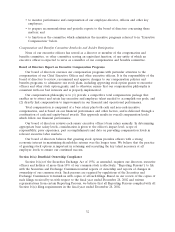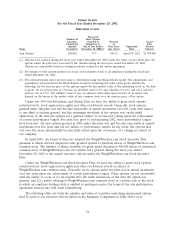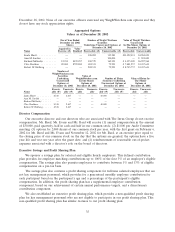WeightWatchers 2002 Annual Report Download - page 33
Download and view the complete annual report
Please find page 33 of the 2002 WeightWatchers annual report below. You can navigate through the pages in the report by either clicking on the pages listed below, or by using the keyword search tool below to find specific information within the annual report.off-balance sheet arrangements or other contractually narrow or limited purposes, such as entities often
referred to as structured finance or special purpose entities.
Seasonality
Our business is seasonal, with revenues generally decreasing at year end and during the summer
months. Our advertising schedule supports the three key enrollment-generating seasons of the year:
winter, spring and fall. Due to the timing of our marketing expenditures, particularly the higher level of
expenditures in the first quarter, our operating income for the second quarter is generally the strongest,
with the fourth quarter being the weakest.
Accounting Standards
In April 2002, the Financial Accounting Standards Board (‘‘FASB’’) issued SFAS No. 145,
‘‘Rescission of FASB Statements No. 4, 44, and 64, Amendment of FASB No. 13 and Technical
Corrections.’’ SFAS No. 145 rescinds SFAS No. 4, which required all gains and losses from the
extinguishment of debt to be classified as an extraordinary item, and amends other existing
authoritative pronouncements to make various technical corrections, clarify meanings, or describe their
applicability under changed conditions. The provisions of SFAS No. 145 are effective for us beginning
December 29, 2002. We do not expect the adoption of SFAS No. 145 to have a material impact on our
consolidated financial position, results of operations or cash flows.
In June 2002, the FASB issued SFAS No. 146, ‘‘Accounting for Costs Associated with Exit or
Disposal Activities.’’ SFAS No. 146 requires companies to recognize costs associated with exit or
disposal activities when they are incurred rather than at the date of commitment to an exit or disposal
plan. The provisions of SFAS No. 146 are effective for exit or disposal activities that are initiated after
December 31, 2002. Accordingly, we will apply the provisions of SFAS No. 146 prospectively to exit or
disposal activities initiated after December 31, 2002.
In November 2002, the FASB issued Interpretation No. 45, ‘‘Guarantor’s Accounting and
Disclosure Requirements for Guarantees, Including Indirect Guarantees of Indebtedness of Others.’’
Interpretation No. 45 requires the disclosure of certain guarantees existing at December 28, 2002. In
addition, Interpretation No. 45 requires the recognition of a liability for the fair value of the obligation
of qualifying guarantee activities initiated or modified after December 31, 2002. Accordingly, we will
apply the recognition provisions of Interpretation No. 45 prospectively to guarantee activities initiated
after December 31, 2002.
The FASB recently issued Interpretation No. 46, ‘‘Consolidation of Variable Interest Entities.’’
Interpretation No. 46 requires that the assets, liabilities and results of the activity of variable interest
entities be consolidated into the financial statements of the company that has the controlling financial
interest. Interpretation No. 46 also provides the framework for determining whether a variable interest
entity should be consolidated based on voting interest or significant financial support provided to it.
Interpretation No. 46 is effective on February 1, 2003 for variable interest entities created after
January 31, 2003, and on June 29, 2003 for variable interest entities created prior to February 1, 2003.
We are currently reviewing Interpretation No. 46 to determine its impact, if any, on our consolidated
financial position, results of operations, or cash flows.
In December 2002, the FASB issued SFAS No. 148, ‘‘Accounting for Stock-Based Compensation—
Transition and Disclosure’’, an amendment of FAS 123, FAS 148 provides two additional alternative
transition methods for recognizing an entity’s voluntary decision to change its method of accounting for
stock-based employee compensation to the fair value method. In addition, FAS 148 amends the
disclosure requirements of FAS 123 so that entities under the intrinsic value method of APB 25 will be
required to disclose the pro forma effect of using the fair value method for any period for which an
income statement is presented. The disclosures are required to be made in annual financial statements
and in quarterly information provided to shareholders without regard to whether the entity has adopted
FAS 123 for recognition purposes. FAS 148’s transition guidance and provisions for annual disclosures
26


